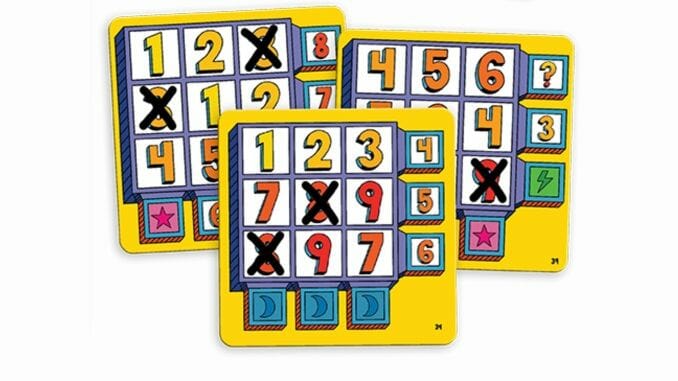Don’t be fooled by Super Mega Lucky Box’s ridiculous name or Schoolhouse Rock-inspired artwork: it’s a great, lightweight game you can teach anyone in a few minutes, and the kind of game even non-gamers will ask to play again. If you’ve played Silver and Gold before, this is a similar game from the same designer, Phil Walker-Harding, taking the flip-and-write concept of the earlier game but making it a little simpler to grasp for newbies.
Super Mega Lucky Box—which I’m going to call SMLB, because come on already—is also a flip-and-write game, which means that on every turn, someone flips a card to reveal a new value that every player then uses to mark off a box on their personal grids. Each player starts the game with three cards showing 3×3 grids that contain single-digit numbers in every box, although they never just show 1 through 9. Each row has a bonus listed at the right end, and each column has a bonus listed at the bottom, and you get that bonus once you’ve checked off all three boxes in that row/column. Completed cards are worth points, with the value going from 15 points if you finish a card in the first round (very difficult) to 8 points if you do so in the fourth and final round. You’ll get another card after each of the first three rounds as well, receiving three from the deck and choosing one to keep.
The flippin’ deck has 18 cards in each, numbered 1 through 9, with two of each. In every round, you shuffle the deck, deal out nine cards, and then flip those one by one for players to use to write on their own cards. That means in most rounds, you’ll see certain numbers twice, while other numbers don’t come up at all. Every player has lightning tokens they can use to modify the flipped number, moving its value by one per token spent. You start the game with four lightning tokens and can gain more as row/column bonuses. They’re worth nothing at the end of the game, so you want to use them… but running out of them can be disastrous, as it may leave you unable to write at all on some turns. Optimal use of the lightning tokens is one of the two keys to playing SMLB well, along with finding the best ways to chain your bonuses so you check off more boxes, since you can get one bonus that lets you fill in another box on any card and perhaps triggers another bonus after that.

SMLB has two other ways to gain points besides the grids themselves. Some rows/columns offer a star as a bonus, which you mark off on your scorecard for the round in which you achieved that bonus. You get one point for one star in a round, four points for two stars, and nine points for three stars. (This is the one point that is unclear in the rules, but Walker-Harding has confirmed this scoring in a comment on BoardGameGeek.) Other bonuses give you a moon token, but those don’t matter until the end of the game: The player(s) with the most moon tokens get six points, and the player(s) with the fewest lose six points. It’s similar to the dessert cards in Sushi Go!, another of Walker-Harding’s games, if you’re familiar with that title. You add up your points for the cards you completed based on when you did so, then add your star points, the moon bonus or penalty, and get one more point for every two marked boxes on uncompleted cards. That’s it. We found winning scores were usually in the low to mid 60s, although we had games where a score of 52-54 won because that’s just how the cards flipped.
SMLB also has a solo mode that works the same way except for the moon bonus—you lose points if you get zero moons, and only gain points if you get two moons or more, with the value increasing as you collect more. You compare your score to a table in the rules. It seems like it would be great fodder for a simple solitaire app, as with the addictive solo app versions of the Clever roll-and-write games (like That’s Pretty Clever!).
The art in SMLB is… not my favorite. I get it, because I’m old enough to get it. It’s there to make us think of Schoolhouse Rock and other 1970s educational shows. I’ve already had one friend who loves games tell me he walked past this title at Target without even giving it a second look, and my family members—who all loved this game once we played it, even my mom, who is not a big board gamer but made us play it two extra times on her 75th birthday this weekend—all reacted skeptically to the box art. So I’m pleading with you to just ignore the art and the silly title. Super Mega Lucky Box is a great, fun, lightweight game for the entire family, including any kids who can handle single-digit addition. (My five-year-old nephew did get bored around the third round, but he had no trouble playing the game itself.) If you liked Silver and Gold, the Clever games, Welcome To…, or Sushi Go!, you’ll definitely love it. And if you haven’t tried those, well, try this one anyway.
Keith Law is the author of The Inside Game and Smart Baseball and a senior baseball writer for The Athletic. You can find his personal blog the dish, covering games, literature, and more, at meadowparty.com/blog.

